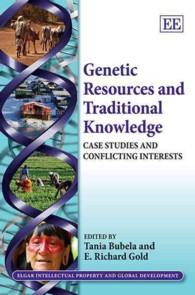- ホーム
- > 洋書
- > 英文書
- > Science / Mathematics
Full Description
With a well-balanced mix of international and Canadian examples, the ninth edition of this bestselling text traces the evolution of the discipline across the globe, examining the ways in which human behaviour transforms the earth's surface in response to changing social, cultural, political, and environmental needs.
Contents
Note- Conclusion- Summary- Links to Other Chapters- Questions for Critical Thought- On the WebIntroduction: The Roads AheadThree Recurring ThemesWhy "Human" Geography?The Goal of Human GeographyAbout This BookThe Human Geographer at Work1. What Is Human Geography?Preclassical GeographyClassical GeographyThe Fifth to Fifteenth Centuries: Geography in Europe, China, and the Islamic WorldThe Age of European Overseas MovementGeography RethoughtInstitutionalization: 1874-1903Prelude to the Present: 1903-1970Human Geography Today: Recent Trends and Subdisciplines2. Studying Human GeographyPhilosophical OptionsHuman Geographic ConceptsTechniques of Analysis3. Geographies of GlobalizationIntroducing GlobalizationGeography as a Discipline in DistanceOvercoming Distance: TransportationOvercoming Distance: TradeOvercoming Distance: TransnationalsOvercoming Distance: Transmitting InformationInterpreting, Conceptualizing, and Measuring GlobalizationThe Global Economic SystemCultural GlobalizationPolitical GlobalizationGlobalization: Good or Bad?4. Humans and EnvironmentA Global PerspectiveEnvironmental EthicsHuman Impacts on VegetationHuman Impacts on AnimalsHuman Impacts on Land, Soil, Air, and WaterHuman Impacts on ClimateEarth's Vital SignsSustainability and Sustainable Development5. Population GeographyFertilityMortalityNatural IncreaseGovernment PoliciesThe Composition of a PopulationHistory of Population GrowthExplaining Population GrowthDistribution and DensityMigration6. Global InequalitiesExplaining Global InequalitiesIdentifying Global InequalitiesFeeding the WorldRefugeesDisasters and DiseasesProspects for Economic GrowthStriving for Equality, Fairness, and Social Justice7. Geographies of Culture and LandscapeA World Divided by Culture?Formal Cultural RegionsVernacular Cultural RegionsThe Making of Cultural LandscapesLanguageReligion8. Geographies of Identity and DifferenceThe Cultural TurnThe Myth of RaceEthnicityGenderSexualityIdentities and LandscapesGeographies of Well-BeingFolk Culture and Popular CultureTourism9. Political GeographyState CreationIntroducing Geopolitics (and Geopolitik)Unstable StatesGroupings of StatesElections: Geography MattersThe Geography of Peace and WarOur Geopolitical Future?10. Agricultural GeographyThe Agricultural Location ProblemDistance, Land Value, and Land UseDomesticating Plants and AnimalsThe Evolution of World Agricultural LandscapesWorld Agriculture Today: Types and RegionsGlobal Agricultural RestructuringFood Production, Food Consumption, and Identity11. An Urban WorldAn Urbanizing WorldThe Origins and Growth of CitiesThe Location of CitiesUrban Systems and HierarchiesGlobal Cities12. The City and Urban FormExplaining Urban FormHousing and NeighbourhoodsSuburbs and SprawlInequality and PovertyCities as Centres of Production and ConsumptionTransportation and CommunicationPlanning the CityCities of the Less Developed World13. Geographies of Energy and IndustryThe Industrial Location ProblemThe Industrial RevolutionFossil Fuel Sources of EnergyWorld Industrial GeographyGlobalization and Industrial GeographiesUneven Development in More Developed CountriesConclusion: Where Next?Changing Human GeographiesA Changing DisciplineBeing a Human Geographer: Where We BeganSummarySuggested ReadingsAppendix 1: Human Geography on the Web NEWOnline Appendices (taken from the 8/e):Online Appendix 3: The Evolution of LifeAppendix 2: Global Physical GeographyA Habitable PlanetGlobal EnvironmentSuggested ReadingsOn the WebAppendix 3: The Evolution of LifeLife on EarthHuman OriginsSuggested ReadingsOn the WebGlossaryReferencesIndex








